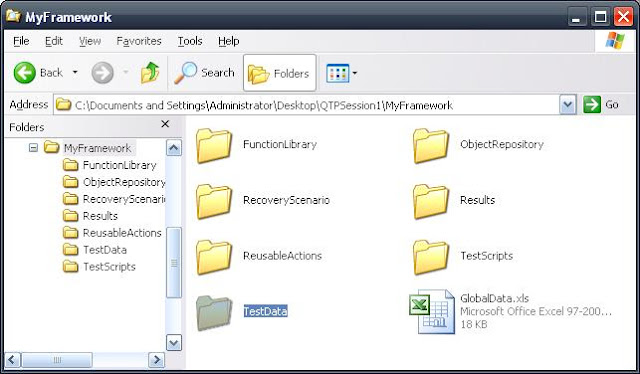Automation Framework Architecture using QTP
Every one knows about the different types of framework
I'm not going to explain you about these framework (Many Authors have done that), I would like to visualize you how you can start off with designing of your framework . . .
I'll try my best to share with clarity and understanding
Well first off all, you should make a mind map (or simply draw a DFD) of the structure of your framework, for example
1) The flow of input data from a storage into your application
2) How you will arrange the output of the application and display/store results?
3) How your execution of scripts would be arranged both locally and in QC?
4) How is your reporting and logger functionality will work?
All this questions definitely come after experience, but people with great Visualization would grasp it easily.
Now their are some aspects of any framework
1) Library files:- which is bundle of functions in .qfl, .vbs, and/or .txt files.
2) Test Data: - The required inputs in your application, which may be stored in excel(mostly), txt, CSV etc
3) Test Scripts: - A place where all Scripts are stored functional and sub functional wise.
4) Results:- A place where your application results/output will be generated. Note that this place can be different in QC and Local folder structure
5) Object Repository: - A place where Global OR is placed if any.
6) Recovery Scenario: - A place to store recovery scenario.
7) Re-Usable Actions: - A place to keep your re-usable actions, if any.
you may also have some other folder to include depending on project.
And now . . . Bundle these aspects under one roof, i.e your framework like below folder structure
Now the layout is ready, how do you let QTP know about these folder structure path, how will you keep this folder called "MyFramework" independent of a place, where-ever you put, it should run seamlessly, either in Company Shared Drive or your desktop, etc.
In short how will you make it Portable or keep integrity of relevant aspects intact.
I have a solution ("GlobalData.xls"), write down the path name of all this structure in an excel file.
See below screenshots.
The Cell formula for "BasePath" is
"=LEFT(CELL("filename",A1),FIND("[",CELL("filename",A1),1)-1)"
Now you might have question why did I Named this excel file as "GlobalData.xls"
I think I gotcha!!!
Put all your data which will be used across your script execution, the data which you would need persistent throughout your script execution like AUT URL, User-ID, Password, all function library file path, etc
See what is the advantage . . .
Put this folder wherever you want, your excel file keep the integrity of the Framework Structure path. I have seen some framework which have many configuration issues if it is migrated to another PC for execution, and time is lost while debugging.
I came up with this intact solution.
Up to me A framework should leverage Re-Usability and should be good in maintenance.
I will tell you how you will bring these data in your QTP "Environment" ;)
Taking about next thing . . . . .
LibraryFiles
What do you think about Managing Object Repository
What kind of Results/Logs do you Generate?
-Pankaj Dhapola


5 comments:
Good Article...Great Job Pankaj....
boss in GlobalData.xls ...u given the path..in every path u used \ backslash.....for me its not working
Can you post where did you have added backslash character in excel formulae?
did you forget double quote?
Good one...
Hello,
The Article on Automation Framework Architecture using QTP is nice. It give detail information about it .Thanks for Sharing the information on Automation Framework Architecture using QTP.
Post a Comment